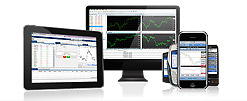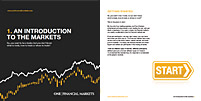

THE COMPREHENSIVE GUIDE TO UNDERSTANDING LEVERAGE
4th November 2019
Leverage in forex trading allows investors to borrow capital to enhance their trading returns. While leverage can generate greater returns, it can also accelerate losses.
What is leverage?
Leverage can be applied to tasks including purchasing a house. A mortgage allows you to pay 20% of the purchase price and borrow 80% of the price from a bank. Borrowing capital enables you to purchase a home without having to have all the money you need to cover the purchase price.
Similarly, leverage that is used in the capital markets allows you to borrow funds to place a trade. Your broker will lend you capital and your collateral (the repayment if you can’t repay the loan), is the value of the currency pair.
For example, a broker might ask you to place 5% on a EUR/USD trade with a notional value of $10,000. You must have a minimum of $500 in your account to make the transaction. You can borrow $9,500 and make a $10,000 trade, as opposed to a trade with a total value of $500. Leverage in forex trading thus enhances levels of capital.
What is a margin account? How do you use it?
To make active trades, you must first create a margin account. Margin serves as a good faith deposit, which your broker uses as the collateral for trades. When you start trading, brokers ask about the account size and other open accounts to determine if they should open a margin account for you and the leverage.
You will also pay interest on money in your margin account when you have an open trade, which is typically the market rate. If your EUR/USD trade has a notional value of $10,000 and you borrow $9,500, your broker will charge you a margin interest rate on that balance. It’s important to find out your broker’s rate. For example, if you borrow $9,500 for one week at 5%, you will be charged $9 = (5% * $9,500)/52. A designation for “used margin” as well as “available margin” might be in your account balance.
What is a margin call?
As the margin changes with profits and losses, you will need capital to meet the new margin. If you accrue losses, your broker will demand an additional charge called a maintenance margin. If your account falls under the maintenance margin level, your broker will make a margin call; an alert that you have a certain number of days to deposit capital or your broker can liquidate your position.
Margin requirements and leverage
Your account’s maximum leverage is based on the margin requirement. For example, if you must post a 5% margin, you can generate leverage of 20:1. As the margin requirement falls, the leverage increases.
Margin-based leverage equals the total transaction value divided by the required margin. For example, if you place a EUR/USD trade that has a notional value of $10,000 and the margin that is required is $500, then your margin-based leverage is 20:1.
You can add more money to your account if one of your trades moves against you. Your risk is more of a function of real leverage, which is leverage based on discretionary capital.
Leverage in trading
Leverage has benefits and costs. If you place a $10,000 EUR/USD trade using 5% margin which is leverage of 20:1, you would post $500 and borrow $9,500. The margin interest rate is 5%. In this hypothetical trade, you make gains of 2% on the total notional value of the trade of $200 ($10,000 * 2%) if your trade only lasted one week.
You would achieve gains of roughly 40% on capital risked. Your gain of $200, is lessened by an interest for one week of margin on $9,500 ($9,500 * 5%) / 52-weeks in a year by $9.13. The net gain is $200 - $9.13 = $190.87. Your net return is 38% since you posted $500.
Why is leverage offered in forex trading?
Forex leverage is typically higher than any other trading vehicle. US equities are offered with leverage that is approximately 1.5 times the stock value, so your margin is at most 50% the notional value of the trade.
Forex leverage can reach levels up to 400:1. Brokers offer this leverage because forex markets are more liquid, less volatile, and always open.
Risks of trading with leverage
While gains are robust, remember that leverage has favourable and unfavourable consequences. A loss of 5% on $10,000 ($500) would diminish the equity you have in this trade. You would incur an interest charge on the initial $9,500, and the $500 of capital borrowed for your unrealized loss as maintenance margin in addition to the margin call. The loss from small changes in the value of a currency pair also exposes you to market, political, and interest rate risks.
Conclusion
Trading the forex markets enhances gains. Leverage involves market risk that can create gains and losses. Trading with borrowed capital allows your broker to charge margin interest. Before trading in a marginal account, understand how leverage can affect money and allocate enough capital to an account.
All content is provided for your information only.
This article may contain opinions and is not advice or a recommendation to buy, sell or hold any investment. No representation or warranty is given on the present or future value or price of any investment, and investors should form their own view on any proposed investment. This article has not been prepared in accordance with legal requirements designed to promote the independence of investment research and is considered a marketing communication. Non-independent research is not subject to FCA rules prohibiting dealing ahead of research, however we have put controls in place (including dealing restrictions, physical and information barriers) to manage potential conflicts of interest presented by such dealing.
One Financial Markets expressly disclaims all liability from actions or transactions arising out of the usage of this content. By using our services, you expressly agree to hold One Financial Markets harmless against any claims whatsoever and confirm that your actions are at your sole discretion and risk.
Begin trading today! Create an account by completing our form
Privacy Notice
At One Financial Markets we are committed to safeguarding your privacy.
Please see our Privacy Policy for details about what information is collected from you and why it is collected. We do not sell your information or use it other than as described in the Policy.
Please note that it is in our legitimate business interest to send you certain marketing emails from time to time. However, if you would prefer not to receive these you can opt-out by ticking the box below.
Alternatively, you can use the unsubscribe link at the bottom of the Demo account confirmation email or any subsequent emails we send.
By completing the form and downloading the platform you agree with the use of your personal information as detailed in the Policy.






